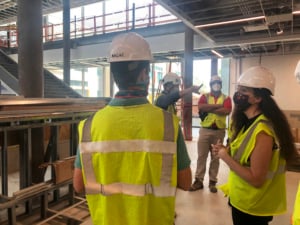Coping with COVID-19: Part III, Impacts on Cost

If you have been following along with our Coping with COVID-19 in the Construction Industry series, you will know that one of the first areas to see impacts from this crisis is cost. In this next installment of our series, we dive into some frequently asked questions related to cost impacts as a result of the coronavirus, along with answers drawn from our own experience and from talking with industry colleagues.
Has MGAC seen a spike in construction costs and supply issues?
The simple answer is no regarding material costs, but it is too early to assess the potential impacts on labor as construction jobs continue to be lost. For now, MGAC has seen no significant material increases, in fact, we anticipate a reduction in material costs in the coming months as global expansion reduces around the world. Already, we are seeing cost reductions with a surplus of steel and crude oil as demand slows. The IHS Materials Price Index (MPI) shows year-to-date prices down 18% and predicts production cuts could be on the horizon, particularly for aluminum, zinc, pulp, and rubber.
As owner’s representatives, we worry about the impact 6 to 12 months down the road, when hopefully our industry is closer to the status quo again. With the industry not fully recovered from the labor dip of the last recession, and with the recent job losses, a sudden increase in construction demand might ultimately lead to a significant increase in labor rates as demand far outweighs supply. Currently, the only impact to labor rates we have come across is the request for hazardous or danger pay due to COVID-19. In a similar vein, some workers, and not just site workers, have been paid extra or received additional benefits to work in ‘hot zones’ like New Orleans hit by natural disasters, while already dealing with the pandemic.
Many firms, including Synergi LLC, a subcontractor for architectural metals and glass based in Maryland, have already become accustomed to disruptions in market supply, including the recent trade wars resulting in heavy tariffs on steel, aluminum, and glass. This has led to firms looking at other supply avenues in Asia or closer to home and moving their eggs from one basket to several to spread risk. On a few projects, we have heard of subcontractors struggling to get materials. Generally, this has been associated with equipment that may be assembled domestically, but requires small pieces from around the world, especially China. If you only have 90% of the materials to build a generator, you cannot deliver it to clients. The bigger issue arises if these materials are on the critical path forward, potentially pushing out the occupancy date.
How are general contractors on MGAC projects reacting to the crisis?
To account for cost changes, it is important to first take note of what is changing on the ground. That, for the most part, starts with general contractors. So far, we have seen many different approaches—all with the purpose of promoting social distancing and cleanliness—but with many variations depending on the site location, construction phase, and state or local restrictions.
Speaking to owners and general contractors, it appears contractors have taken the onus to implement site safety measures, often with agreement from the owners. Primarily these have stemmed from CDC and OSHA guidelines, again with variations depending on the unique needs and circumstances of the project. On the sites we are currently working on, we have seen the following almost universal measures:
- Social distancing measures for site workers between each other and others, such as delivery workers.
- Additional communication through daily toolbox talks, letters, and onsite signage addressing workers on rights, precautionary advice, and best practices for safe work.
- Infectious disease control planning.
- Newly implemented work schedules, often with longer days, but fewer full days onsite.
- Shift premiums relaxed.
- Additional hand wash stations and use of sanitizers.
- Employee check-in / health screening, sometimes involving temperature checks.
- An increase in communication / education between general contractors and subcontractors.
- Quarantining ill or potentially ill workers.
- Increase in cleaning measures.
- Implementation of masks and other PPE, often before State or City requirements.
- Contact tracing on and offsite to help health workers.
- Restrictions on tool sharing without decontamination.
- Expanding lunch / rest areas.
- Restrictions on who / how many can enter trailers.
Some measures that we have seen intermittently include additional supervision to monitor social distancing at places like stairwells, elevators, and gated entrances. Some sites have shutdown protocols for when a worker tests positive and, in rare cases, some are using decontamination trailers and negative pressure as precautionary measures.
These changes have had a positive impact on sites slowing down the virus spread, but they have led to some potential contract questions regarding liquidated damages and time extensions. Talking with Will Englehart from Clark Construction, his biggest worry, first and foremost, is employee health and safety. However, when asked about project durations, he agreed there could be a reduction in productivity and therefore a potential increase in project duration. That said, Clark Construction is doing everything to mitigate delays without sacrificing safety and staying within CDC guidelines, and frequently communicates with owners. In speaking to an anonymous contractor, the above measures are meant for everyone’s safety, but there are fears the benchmark of 60% productivity during the day installing their particular trade could drop, especially while workers adjust to the new norm. For example, using PPE is essential on job sites, but it is not ordinarily used as widely as it is during this pandemic, which can cause a slowdown in work and communication. Some of the immediate issues MGAC is seeing onsite which may concern owners are:
- Reduction in productivity for many reasons (adjusting to PPE, new teams, schedule changes, slowed deliveries).
- Increase in contractors’ costs (additional cleaning, PPE, supervision, cost of signage, etc.).
- Increase in accidents due to protective equipment difficulties.
- Quarantining of certain subcontractors.
- Temporary site shutdowns.
- Potential legal issues as a result of shutdown avoidance despite guideline recommendation.
Who will pay for these additional precautions taking place?
There is no question COVID-19 is going to cost projects money—the question is “what is a legitimate expense and who will pay for it?” Broadly speaking, this can be broken down into two groups. First, there will be the physical cost, such as PPE, disposal services, cleaning tools / services, wash stations, and more. These are the things you can immediately see. Second, will be the potential extension in time due to a reduction in productivity, slow supply chain, and temporary site closings—the things you do not physically see. These are more difficult to address, and payment responsibility will depend on your contract and where the project stood before the coronavirus impacted the project.
According to OSHA Section 19.10, employers are responsible for employee protective equipment, whether that be headgear, protective glasses, or face masks. Although the OSHA Act of 1970 does not specifically address airborne diseases, there is a “General Duties Clause,” which simply says employers “shall furnish to each of his employee’s employment and a place of employment which are free from recognized hazards that are causing or are likely to cause death or serious physical harm to his employees.” Additionally, OSHA recently released guidelines to prepare workplaces in the face of COVID-19, and although not legally binding, these guidelines reinforce the employer’s responsibility for providing a safe work environment.
In regard to extensions of time, this will undoubtedly unravel over the next year or so with potential change orders, probable court disputes, and new legal regulations from government agencies. This portion of the question will be addressed in more detail next in our series, but our first recommendation to owners is to establish where the project was cost- and schedule-wise before the impact of COVID-19 to make sure there was a line in the sand agreed upon by all parties. Who pays for these extensions of time will depend on the type of contract, the detail in clauses for additional time, and the relationship with the owner. Whether a pandemic or epidemic is or is not listed in the contract does not really matter, because most all construction contracts contain a clause that affords relief in circumstances outside of the contractor’s control or arising from unforeseen conditions or circumstances. Such clauses entitle the contractor to additional time, and potentially, compensation providing they can prove it. No doubt many large general contractors have been taking daily logs specific to the impact of COVID-19, and diving into schedules to make regular annotations. We recommend owners do the same to have the means to defend themselves in the future, if needed, and to offer transparency in these unprecedented times.
Much more to come on this topic and more in our next two installments of the series, including:
Part IV: Impacts on Contracts
Part V: Impacts on Future Planning









